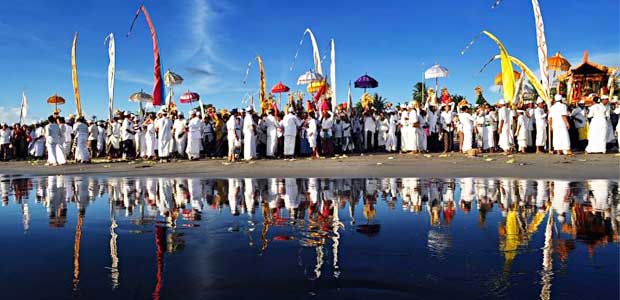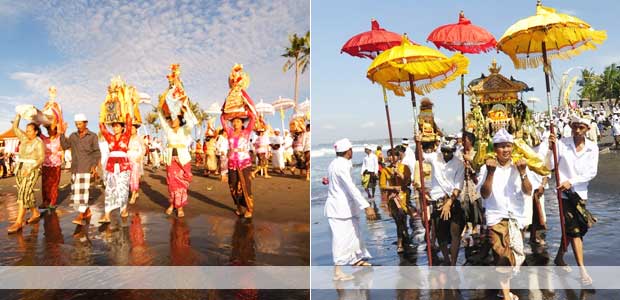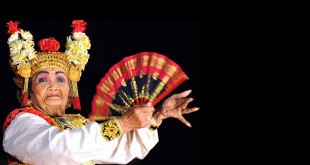
The Melasti ceremony is a stage of the Silent Day celebration where the Balinese take the Pratima to the sea for purification. Although there is the option to use modern transportation, the Balinese people maintain their culture by taking the Pratima on foot. The Pratima is believed to be a manifestation of God’s power, symbolizing each function. Typically, the Pratima is made of metal or wood and shaped according to the visualization of each function.
Held once a year, the march of Melasti is usually done three days before the Silent Day of Nyepi, welcoming the New Year of Çaka in the Balinese calendar system. The purpose is to purify both Bhuana Alit (the soul) and Bhuana Agung (the universe). Further more, the Melasti ceremony brings four values to the Balinese-Hindu society: to remind people of their devotion to God, to build awareness for the alleviation of suffering in living together as a society, to strengthen the soul with spiritual self-cleansing, and to preserve nature.
Performed with a parade procession by thousands of Hindu people as participants, the ritual begins with the preparation of a walking crowd with the Pratima placed in a jempana, a carriage for the Pratima, and paraded towards a water source (a lake ora beach) that is located not far from the temple in a nearby village. People walk together and help each other to bring the Pratima to the water source with a percussion accompaniment called a Beleganjur.
At the edge of the water source, the procession takes the holy water for a cleaning ritual dedicated to all participants and the Pratima to follow as the next step. This spiritual concept of a cleansing procession is to eliminate the suffering of the people from the attachment of the material world.

After the cleansing procession, all participants pray facing the water source with hope to have a better life. The praying session is led by a Pemangku. After the prayers, the participants will carry the Pratima back to the temple. People who happen to be in the area will join the session sitting cross-legged while praying to God for the salvation of all sentient beings, including the parade participants.
After the Pratima is placed back at the temple, the ceremony continues with a prayer procession held at the temple. It is called the Upakara Mecaru, in which they present caru, which is an offering, addressed to the evil spirits who live in this world.
For several days after the Melasti ceremony, all the residents nearby the temple do puja, presenting offerings called prani. At this time, people are asking tirtha amrta(holy water) at the temple for the welfare of their lives, all beings, and the universe.
The Balinese believe that all parts of the Universe have their own purpose, including the evil spirits, which they believe should not be dismissed but are to be controlled so they will still be able to fulfill their purpose in this world. As Balinese-Hindus, they believe that to sense heaven in this world is to live without polarity. There is no good, neither bad. All are the same; they present with certain purposes.
Joining the whole process of the Melasti Ceremony is similar to taking steps through the tunnel of a spiritual journey it self. Thousands of people of all ages come together in the parade, linking themselves with all parts of the universe. The adrenaline and positive vibrations delivered by people who “crossed their hands” along the streets saying Mantras, giving energy to all participants.
However, in recent years the pros and cons of the Melasti Ceremony arise. Some communities, who are juggling their wheelson the already busy streets in Bali, feel quite disturbed by the parade. Similarly, waste problems arise after the ceremony is held. It is undeniable that the progress of Bali’s developmentand the diversity of the community interests in the increasingly pluralistic Bali will lead to a polarity of an implementation of activities. In spite of it all, the Balinese-Hindu community continues to perform this ceremony as part of their worship and attempt to find spiritual awareness.
It is a spiritual journey. It is magical. The hundred miles long march is only taken by a journey within only half day on the streets; walking and sometimes running across the busy traffic of Bali’s streets. With all the purpose and in the name of tradition, not only the Balinese society should support this unique ritual, but also other communities that live side by side and the higher power of the society, the government it self, to guide all the people while doing this sacred ritual.
Source: bali & beyod magazineText by Gede Bayu Rahanatha




